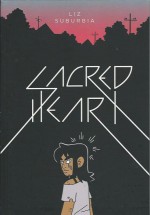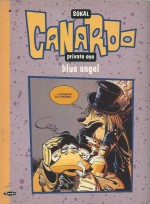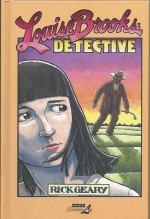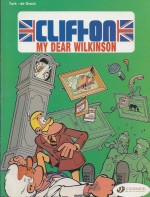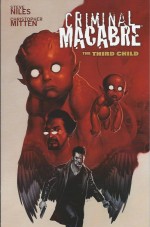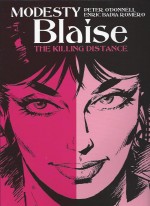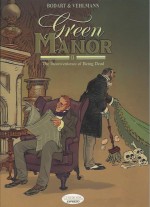
By Bodart & Vehlmann, translated by Luke Spear (Cinebook Expresso)
ISBN: 978-1-905460-64-9
The French are generally considered more passionate than us Brits and always eager to dole out grandiose appellations and epithets about creators, but they’re very seldom wrong in their acclamations. Writer Fabien Vehlmann was only born in 1972 yet his prodigious canon of work (from 1998 to the present) has earned him the soubriquet of “the Goscinny of the 21st Centuryâ€.
Vehlmann entered the world in Mont-de-Marsan and grew up in Savoie, studying business management before taking a job with a theatre group. In 1996, after entering a writing contest in Spirou, he caught the comics bug ands two years later published – with illustrative collaborator Denis Bodart – a quirky, mordantly dark and sophisticated portmanteau period crime comedy entitled Green Manor.
The blackly funny pastiche of Victoriana’s seamy underside appeared sporadically until 2005 (and was revived in 2011), whilst the author spread his wings with a swathe of other features such as Wondertown (with Benoît Feroumont) and hugely popular children’s thriller Seuls (with artist Bruno Gazzotti) before undertaking a high-profile stint on prestigious all-ages adventure strip Spirou et Fantasio.
Vehlmann continues to craft enticing, engaging tales for kids (Samedi et Dimanche) but is equally at home with more mature fare like Sept psychopathes (with Sean Phillips). For a while he even drew his own strip Bob le Cowboy…
Partner-in-perfidy on Green Manor Denis Bodart studied at the Saint Luc academy in Brussels before taking up teaching. He too soon descended into a life in comics, debuting in 1985 with Saint-Germaine des Morts (scripted by Streng) for publisher Bédéscope.
Three years later he co-created – with writer Yann (Yannick Le Pennetier) – Célestin Speculoos for Circus and Nicotine Goudron for l’Écho des Savanes whilst earning a crust as a jobbing freelance comics artist with work regularly appearing in Spirou and elsewhere.
Following his highly acclaimed turn here he moved on to succeed Jean-Maire Beuriot as artist of Casterman’s prestigious Amours Fragiles.
This double-length compact Cinebook edition compiles the final pair of original volumes – De l’inconvénient d’être mort and Fantaisies meurtrières – which saw Green Manor’s continual catalogue of high society crime, calumny and depravity lead to its inevitable sorry conclusion…
The premise is deliciously simple and wickedly palatable. As seen in the first collection, prominent alienist Dr. Thorne has become obsessed with an inmate known as Thomas Below currently incarcerated in the infamous Bethlehem Psychiatric Hospital.
That poor unfortunate had served as a discreet domestic in a private Gentleman’s Club for his entire life and became violently delusional mere days before retirement. Thorne questions the madman and realises the sorry soul before him believes he is Green Manor incarnate. He has certainly been privy to all that strange place’s secrets, surprises and hushed-up scandals, but can the horrific and bizarre tales he shares possibly be true in whole or in part?
The Inconvenience of Being Dead resumes the unconventional interviews in 1899 as Thorne is dragged from his bed to attend Below once again, but this time the need is most urgent. The old retainer has escaped, broken into a house and taken a family hostage.
Hesitantly the healer makes his approach and engages the affable maniac in conversation and all too readily Below begins telling more tales of rich, powerful and ostensibly honourable men at their most excessive and unbearable…
The macabre menu of skits and sketches begins with ‘Child’s Play’ from March 1871 wherein cruel Lord Virgil observes and is incensed by a passive, gentle servant with the patience of Job instantly resolving to turn the saint into a murdering thing of evil.
Admitting to possessing a foolproof, infallible and much proven method of killing-by-proxy to a roomful of The Great and the Good gathered around, Virgil determines to drive good-natured George into eternally debasing and damning himself by using the process to save himself from torment.
Sadly one man’s torment is another man’s test of faith and the good George is far from predictable…
In 1885 dilettante supernaturalist Joseph Sharp returned from Prague after a fruitless shopping trip for magical spells and objects to find his best friend Mark Abbott languishing under the force of a family curse. However, detailed investigation of ‘The mark of the beast’ and a ghastly family secret in a crypt only proved once again that the unknown has very little force or impact when measured against a mother’s hate, the infinite patience of the tormented and a victim’s fevered imagination…
One night in 1876 Lord Justice Sherman realised he had condemned an innocent man to death, even though not a shred of evidence existed to confirm his opinion. With one night remaining to save his man, the elderly jurist took to the streets of London to find the true culprit and succeeded, utterly unaware that the malefactor involved had already taken vengeance for the judge’s noble act in advance of its completion and Sherman’s ‘Last Wishes’…
In 1897 bombastic, belligerent General Miller gloated at the Club that he had at last come into possession of the fabled Spear of Longinus. The military martinet had no fear of the legends and many deaths laid upon the artefact or ‘The Centurion’s Shadow’, but was beguiled by its repute as a tool to make great men all-conquering.
Nevertheless he was soon one more corpse attributed to the talisman – and not the last – until a pair of the Club’s armchair investigators applied learning and logic, exposing a deadly trap constructed by one of history’s greatest thinkers…but just a little too late…
With the hostage crisis coming to end Below tells his most shocking epigram as ‘Voodoo Night’ finds the gathered gentlemen casually dissecting a juicy murder one night in December 1870 over cigars and brandy.
With irreconcilable facts and impossible assumptions heatedly flying about, soon only absurdity or the supernatural are left as answers to the mystery of the slaying of boorish lout Lord Killian, but in another room the genteel conversation of the closeted Ladies married to the assemblage of tobacco-smoking idiots soon reveals a so-simple truth…
The last legends of the Club are gathered in Murderous Fancies as the increasingly obsessed Thorne receives word that Below has passed away. Briefly thinking himself free at last, it is with mixed feeling that the doctor takes custody of the illegible scrawls of the troubled retainer and wearily, warily begins to decipher them…
‘Endgame’ relates an incident from June 1871 when the Club was driven to distraction by the will of recently paralysed Lord Wyatt. It was in the form of a nonsense riddle and the first to solve it would win all Wyatt’s prodigious wealth…
At the same time the executor secretly consults with dementia expert Dr. Sheffer over the mental state of his master. The aristocrat claims his parlous condition is the result of a murder attempt and this riddle might well be a trap to catch the assailant. Sheffer knows better but soon has every reason to regret his rash conclusions…
‘A Small Crime Serenade’ finds an aged and innocuous gentleman in garrulous mood one night in 1867, sharing with a dutiful Club servant his great gift and passion: a life-long ability to get away with murder. Sadly his boast of capping his career with one final killing is derailed by a most unanticipated event…
In 1827 talk at Green Manor was of only one matter: the recent demise of a radical libertarian poet. Especially fervent was young devotee Dr. Daniel Ballantyne who promptly fell for a cruel prank when the Club grandees purportedly offered him a chance to autopsy the body and look ‘In the Head of William Blake’. They had arranged that what he saw would be like nothing he had ever experienced…
Ballantyne disappeared that night and in the cold light of day an inexorable campaign of terror began as the japesters were slowly driven mad by notes threatening vengeance from the “Tygers of Wrathâ€â€¦
In lighter vein, ‘Fight to the Finish’ related how two bored big game hunters invented an imaginative game in May 1859. Their aim was to determine who exactly was the absolute best. The prey was to be each other but, although the rules of the competition were strict and fair, as the days progressed it seemed that neither Lord Bennett nor Lord Turner were as able or as gentlemanly as they claimed…
The dead man’s tales ended with a chilling homily from 1872 wherein the cream of society discussed the strange case of Lord Sanders who had blighted his own financial empire and destroyed his greedy heirs by cruelly and carefully tying the purse-strings of their inheritances.
The dominating oligarch had left a vast list of tasks for his four children to fulfil in ‘The Testament’; far too many for any person or persons to complete before getting their undeserving hands on his ill-gotten gains.
Of course even he could not predict how and where greed and frustration could take a desperate man…
And with that final story shared, Below no longer plagued the good doctor’s days, but his influence remained long after he was gone…
Wry, witty, wickedly funny and sublimely entertaining, The Inconvenience of Being Dead offers a supremely damning glimpse at High Society’s low morals which will delight and astound lovers of sly crime fiction, rich black comedy and classy comics confabulations.
Original edition © Dupuis 2005 by Vehlmann & Bodart. All rights reserved. English translation 2008 by Cinebook Ltd.


